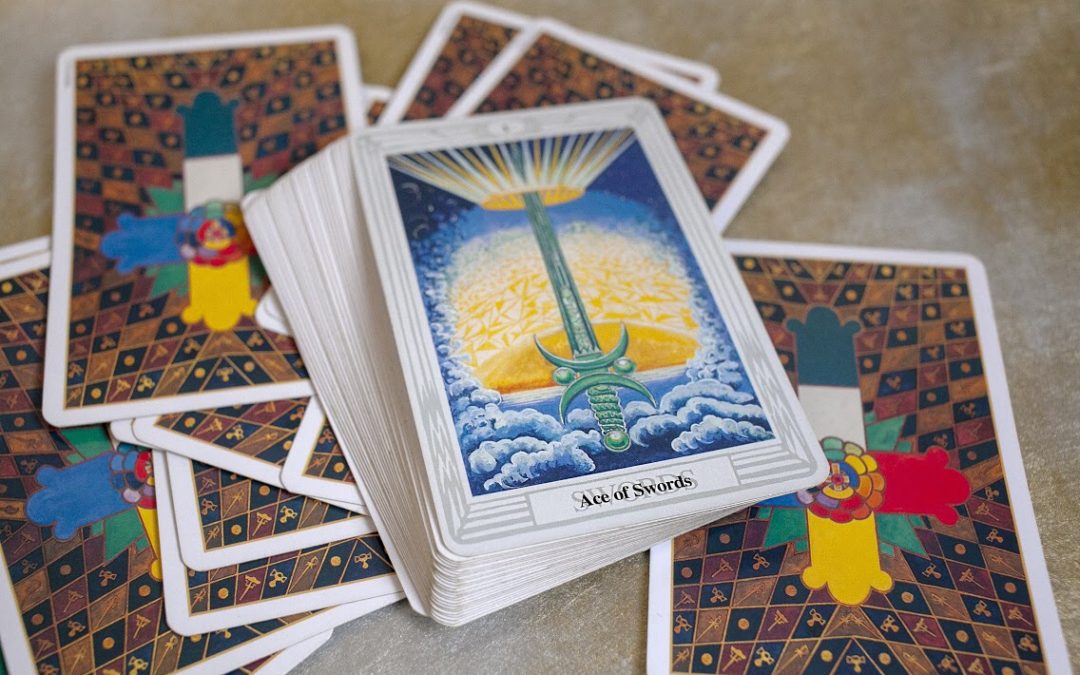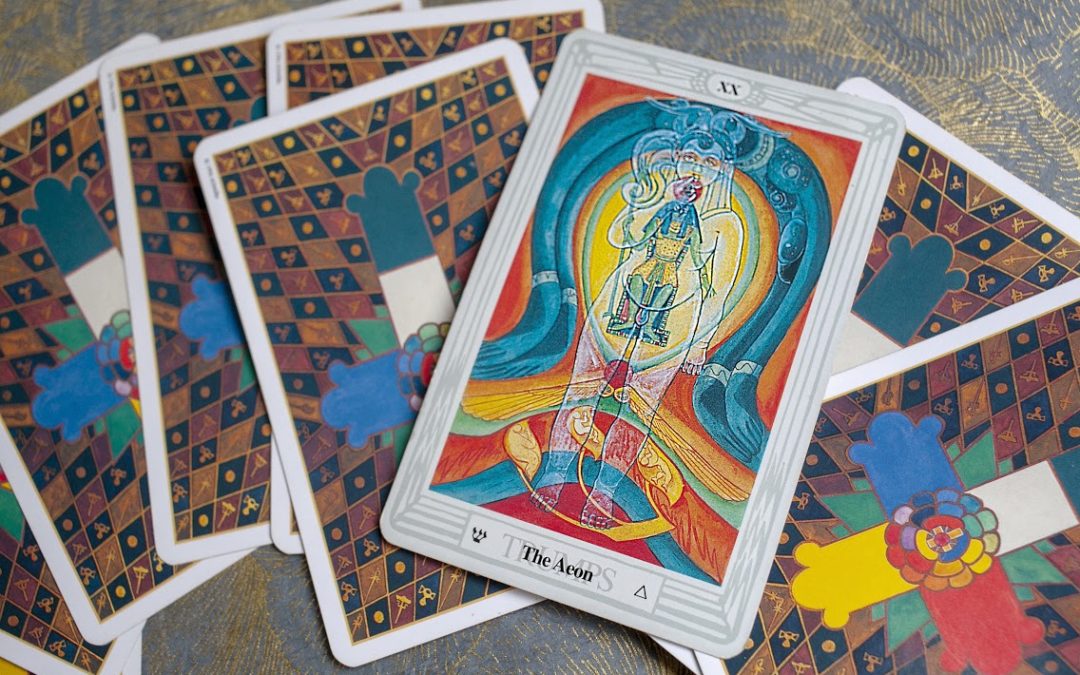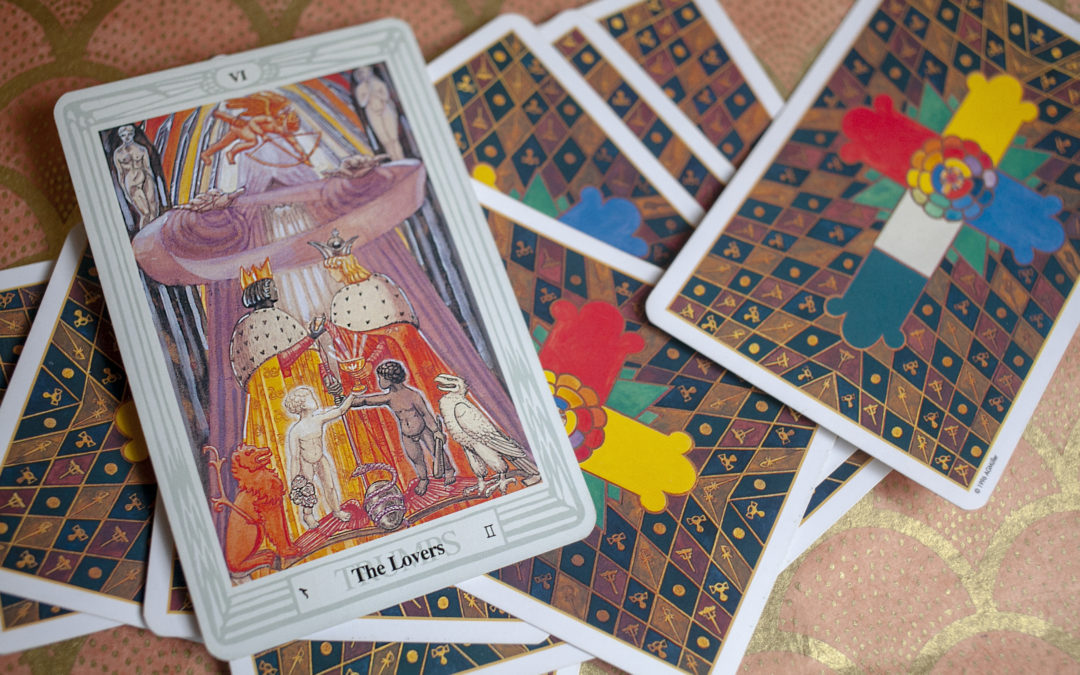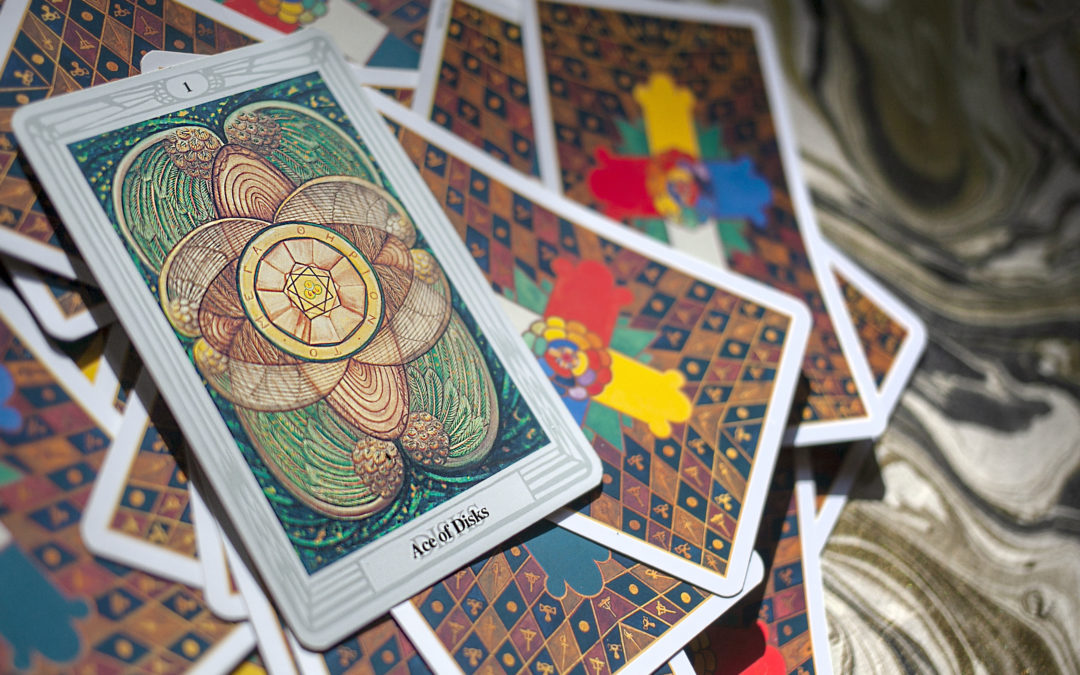
by Kosmic Tonic | Mar 19, 2019 | Tarot
This card is attributed to the letter Nun, which means fish; the symbol of life beneath the waters; life traveling through the waters.
So begins Crowley’s interpretation of the Death card. Ever a contrarian, he opens with an emphasis on life.
This card is represented by the sign of Scorpio, as indicated by the scorpion on the bottom right. Though the planet Saturn has no relation to Scorpio, his symbolism is prominent in this card: the skeleton figure, every bit the Grim Reaper, and his scythe. Saturn may be the lord of death among astrologers, but he also represents structure and form. Death has a way of dissolving, or defying both.
Crowley’s Death figure is unlike other decks’ representations in that he wears the helmet of Osiris. Osiris, Lord of the Underworld, brother-husband to Isis, unceremoniously dismembered by their younger brother, Set.
In this card, he dances a gruesome jig, his legs forming the sigil of planetary Saturn (♄). In the Middle Ages, a fixation on death (possibly due to the plague) inspired representations of the “dance of death,” or danse macabre, in literary and visual art: a parade of live and dead figures wiggling toward their doom. The figures were arranged by rank: from Pope and Emperor to child or clerk, all cavorting to the same loading dock, as it were. These images captured that certainty and impartiality of death; in so much Saturn represents hierarchy and authority figures, Death further suggests his undoing.
Crowley’s Death card also indicates the three “levels” of Scorpio:
- the scorpion
- the fish or snake (painted in almost the same brush stroke)
- the eagle (featured in the top left, above Osiris’ head)
I encountered this archetype of Scorpio-as-Eagle early in my studies of astrology, and it always threw me for a loop. However, the archetypes are explained in the astronomy: the constellation Scorpius sits beside Ophiuchus, “the serpent bearer,” and Aquila the eagle.
The scorpion archetype represents the primal, bottom-feeding, even self-destructive urges of this sign. The earthbound Mars energy that thinks with his… root chakra. An (unsubstantiated) myth of scorpions in nature suggests that they’ll sting themselves in the head if surrounded by a ring of fire. The Scorpion “level” of Scorpio may not sound very flattering, but it’s necessary. We would be nowhere with our basest urges to eat, protect ourselves, procreate.
The fish or snake represents the regenerative quality of Scorpio. The fish was understood as a symbol of rebirth in Egyptian mythology, especially the tilapia, who carry eggs in their mouths until they hatch. Then of course there’s ichthys, the fish symbol for Christ. Snakes too embody the idea of rebirth and transformation: after all, they shed, and re-grow, their own skin. And as Esoteric Meanings eloquently words it: life and death are two curves of the same serpent.
The final “tier” of Scorpio is the least intuitive: the Eagle. Deborah Houlding writes compellingly of this archetype: If, as the Egyptians thought, scorpions represent initiation into the sacred mysteries, we can consider the sign’s other related creature, the eagle, as a higher expression of Scorpio power…Transcendence from the crawling scorpion to the soaring eagle, still predatory, still conveying the essence of patience and penetration, but capable of flight and height, brings together the theme of destruction and renewal as a story of evolution.
From the earthly urges of the scorpion, through the regeneration of the fish / snake, to transcendence, the soaring eagle, and access to the mysteries: the sign Scorpio and the card Death contain all three. And it may not present as a gradation, or an evolution: we can engage on all three planes at once. And we do.
When this card turns up, consider the forms or structures or habits you are releasing. Know that transformation may involve a journey into the dark. It may involve detachment and letting go of what we perceive to be important, but an Eagle (or phoenix) awaits you on the other side. Only through certain sewer journeys do we find constructive change, necessary shedding, and higher knowing. Maybe that’s why it’s hard to freak out a Scorpio: they have the impenetrability of experience about them. They’ve been there. Shed that. And come out (relatively) unscathed.
A Zen proverb captures this card rather bluntly: Let go, or be dragged.
References:
Esoteric Meanings
The Book of Thoth
Deborah Houlding

by Kosmic Tonic | Mar 16, 2019 | Tarot
The Ace of Swords is the root of the Air element: the purest essence of Air, which we associate with the mind, words, and law. For what is law but language? Indeed, θέλημα, or “THELEMA” is inscribed on the blade: the Greek word for “will,” or “the word of the law” for Crowley. Immediately, I think of the Sword of Justice in the Adjustment (or Justice) card. And the Queen of Swords, a head dangling from her fist. That ruthless, stone-eyed face the law can have: “blind,” in theory, for better or worse.
Some of the symbolism on this card is difficult to grasp if you’re not familiar with the Kabbalah. It is said that Air is formed from the union of Fire and Water: and so we see the sun rising from the lake or ocean, the clouds sudsing around it. Maybe you don’t need to know the Kabbalah to understand this one after all. What happens to water when we boil it?
The crown is lit by 22 rays: perhaps representing the 22 major arcana, or the 22 pathways of the Tree of Life. All of the aces correspond to Kether in the Tree: the topmost sphere, considered so sublime it’s completely incomprehensible (to us.)
A snake coils six times around the hilt, which is said to be of copper, Venus’ metal. There seems to be a symmetry implicit in that: Venus countering the violence of the sword. The crescent moons balancing the Sun on the water. We say a strong mind is “level-headed,” another word for balanced.
If you’ve dabbled in the Tarot, you’ll have noticed that many cards in the Sword suit have more negative or challenging connotations. In this deck, the Ten of Swords is captioned “Ruin,” the Five of Swords, “Defeat,” the Nine of Swords, “Cruelty,” and so on. It makes sense in a way. We only experience difficulty with our mind. As told in the old adages: “ignorance is bliss” (and so what is the opposite), or “curiosity killed the cat.” Once we turn our brains on and really examine the story we’ve found ourselves in, we get into trouble. A blue pill / red pill conundrum.
Red Pill: “a life of harsh knowledge, desperate freedom, and the brutal truths of reality.”
Blue Pill: “a life of luxurious security, tranquil happiness, and the blissful ignorance of illusion.”
The Ace of Swords seeds the air signs: Gemini, Libra, Aquarius. All of them cutting, in their way, wielding their minds as battle axes to learn, find justice (or balance), and project their ideals onto humanity.
The Ace of Swords can indicate a fresh idea. The light bulb moment. Epiphany. It is the root essence of honesty. Clear thinking. The sword severs, and this is a suit (or element) of detachment. The sword pierces the fugue of emotions. And yet, it’s not confined by the materiality of the earth element. It sees beyond corporal bodies, into the logic (and logos) of things. The Air element thinks, calculates, articulates. Articulate, from articulare, “to separate into joints.”
As the root of the Air element, the Ace of Swords seeks fairness, social justice, the truth. Another tired expression: the pen is mightier than the sword. So is the brain. Funny how the Air element represents all three.
If you surrendered to the air, you could ride it. -Toni Morrison

by Kosmic Tonic | Mar 4, 2019 | Tarot
This has been one of the hardest Thoth cards for me to tap into: partly because I’ve read so many conflicting interpretations. Angeles Arrien describes the central gods as Osiris, in child and adult forms. Except the falcon-headed god at the centre is unambiguously Horus, Osiris’ son. Even the gauzy child overlay resembles Horus the Child, who was depicted in statues as a naked boy with a finger pressed to his mouth. Interestingly, this hand position features in the Egyptian hieroglyph for “child.” It’s possible this symbol was actually misinterpreted by Greek and Roman poets to mean “silence.” And so Harpocrates, the Greek God adopted from Horus, became the God of secrecy.
To me, he still resembles a boy licking honey (or jam, or ice cream) off his finger.
I think, too, of the word “horizon.” How it seems to contain the words “Horus rising,” or even “Horus sun,” even if the etymological link is invented: symbolically pleasing, but ungrounded in history. It is true that Horus became the Egyptian Sky God, and that in child forum, he represented the newborn sun warming the dawn horizon.
Back-bending over child and adult Horus, is Nut (or Nuit or Nuith), the goddess of the night sky. Angeles Arrien describes her shape as the glyph for Leo. Angel Paths connects her form to the ankh symbol. Esoteric meanings calls it the omega. The latter seems most likely to me. The Aeon card correlates to “Judgment” in other decks, and the Omega echoes that Biblical imprint: “I am the Alpha and the Omega, the first and the last, the beginning and the end.”
And I suppose that’s where the interpretation really begins for this card: both its iteration in more traditional decks as “Judgment,” and here as the Aeon, or an immeasurable period of time. The card orbits the threshold between midnight and dawn; child and adult; life and pre-life, indicated by the fetal figures nestled in the Hebrew letter ש (pronounced “shin” or “shein.”)
Crowley’s religion, Thelema, identified three aeons: the Aeon of Isis, the Aeon of Osiris, and now, the Aeon of Horus, defined by self-realization and self-actualization. It aligns closely with our conception of the Age of Aquarius: a sort of idealizing of our present potential and the future we’re tipping into.
In Little Essays Toward Truth, Crowley writes: The Aeon of Horus is here: and its first flower may well be this: that, freed of the obsession of the doom of the Ego in Death, and of the limitation of the Mind by Reason, the best men again set out with eager eyes upon the Path of the Wise, the mountain track of the goat, and then the untrodden Ridge, that leads to the ice-gleaming pinnacles of Mastery.
So what does this all add up to?
Time. Self-evaluation and evolution. Potential.
A theme of triplicity dominates this card. There’s no obvious link to any of the signs or planets of the zodiac, but a trine symbol (△) at the bottom right, opposite the Hebrew ש (“shin.”) According to Rabbi Aaron L. Raskin, the three vertical lines of ש represent the three dimensions of a human being: kesser (will and pleasure), the intellect and emotions.
Shin has fine definitions in Hebrew. The one Crowley focuses on is “tooth.” I first interpreted this in a threatening way… the “tooth” of judgment like the “fist” of Saturn, or some other punishing body part. But there’s also the connotation of chewing your food before you eat it: chewing over an idea before you act.
When you combine all of these symbols together: Horus, the three aeons, Night in wheel pose, the fetal figures painted in the golden rod ש, alongside the traditional interpretation of this card as Judgment, the key message seems to be: only you are responsible for your own thoughts, action and evolution. The author at Angel Paths phrases it well when she says: The Aeon forces us to acknowledge that our actions set up a chain of cause-and-effect for which we are solely responsible. Here we pass through the fire of purification, shedding dead and dying wood as we go. We judge ourselves frankly, forgive, and leave the past behind.
There is a theme of archways. Of passing through. Not passively awaiting our day of judgment, but turning an eye onto our own patterns, our own participation in games.
As Camus writes in The Fall: I shall tell you a great secret, my friend. Do not wait for the Last Judgment. It takes place every day.
When this card comes up in readings, it may indicate a turning point. A moment where you pass into a new phase (or aeon.) All of your decisions and actions until now have led to this moment. You are your own gatekeeper. Trust yourself.
References:
Camus, Albert. The Fall.
Crowley, Aleister. The Book of Thoth.
Crowley, Aleister. Heart of the Master.
Raskin, Aaron. “Shin—The Matriarchs.”
Angel Paths
Esoteric Meanings

by Kosmic Tonic | Feb 28, 2019 | Tarot
My lasting sensory impression of this card is velvet—or another sumptuous textile, maybe polar bear fur. The Lovers is the 6th card of the major arcana and the first featuring more than one figure. The imagery is so Venusian, I might have assumed the correspondent sign would be Libra or Taurus…but it’s Gemini.
On first glance, this card couldn’t appear less like the Twins. It feels opulent. Heavy. Weighted like bodies or feelings. When I think of Gemini, I imagine more aerial beings, like bees whisking between stalks of lavender, spreading their pollen. (There is actually bee imagery on this card, if you look closely: on the Empress’ robe. By contrast, the Emperor wears snakes.)
But the entire card is a mirror. At this point it is worth acknowledging that the card itself is a twin to the Art card (equivalent of Temperance in other decks.) Both cards feature twin imagery, and they mirror each other. In The Lovers, we see a red lion and white eagle. In Art, these colours are reversed. Two naked babes stand at the centre: one carries a bouquet of flowers and a chalice. The other, a hammer and a lance. According to Crowley, they represent Cain and Abel. Above them, we see the Emperor and Empress, and above the Emperor and Empress: a violet wizard (the Hermit), his face shrouded by the magic that whips about his hands. At the top, we find two nude figures: Lilith and Eve. Cupid arcs over the Hermit with his bow—and even this shape is reflected in the hidden bow at the bottom of the card, which nestles an Orphic Egg. It’s one of the most complicated cards in the deck.
In his Book of Thoth, Crowley writes: “Each of these symbols is in itself double, so that the meanings form a divergent series, and the integration of the Card can only be regained by repeated marriages, identifications, and some form of Hermaphroditism.”
I like this sentence as it applies to Gemini minds: themselves double, forever spinning a divergent series of thoughts, finding integration by way of repeated symbolic marriages, identifications, “and some form of Hermaphroditism.” (Side note: Hermaphroditos was the son of Hermes and Aphrodite. As the name implies, they possessed traits of both sexes.)
It makes me think of how light shines off the surface of the ocean: catching many faces in the surface of the wave. Does that make the light, or the wave, inconstant? Only if you’re fixating too narrowly on fluid shards of water. Only if you’re trying to fix a moving thing.
Gemini’s air element may be represented by the sacred lance in the centre of the card. There are also swords in the background, curved and projecting a form of cage. This imagery is important because sharp items sever. How do you reach two? By splitting the one in half.
Chani Nicholas writes that no one looks harder for their counterpart than Gemini. As if they yearn toward a mirror image they can’t fully embody on their own: not without shifting, not without tasting everything. Not without reaching and bending and veering toward their imagined twin.
Angeles Arrien’s interpretation of The Lovers card begins with a quote from Anais Nin: “The value of personal relationship to all things is that it creates intimacy and intimacy creates understanding and understanding creates love.” And love is not singular. What we use one word for in English, other languages find plural; Arabic includes eleven words for love; Sanskrit has 96 (!). Ancient Greek differentiates between eros (passionate love), philia (friendship), storge (parents and children), agape (universal love), ludus (playful, 5th house love), pragma (enduring love), and philautia (self love), among others. All shifting faces in the body of a wider ocean.
References:
Book of Thoth by Aleister Crowley
The Tarot Handbook by Angeles Arrien
Chani Nicholas’ Love Horoscopes

by Kosmic Tonic | Feb 21, 2019 | Tarot
The Ace of Disks represents the root of the powers of Earth, which Crowley did not view as passive or inert, but active, in motion. To highlight this animated quality of earth, the Thoth deck invokes a whirring disk, rather than a coin or a pentacle. Crowley writes: Thus, in particular, the old conception of the Earth as a passive, immobile, even dead, even “evil” element, had to go. … Nor are the Disks any more to be considered as Coins; the Disk is a whirling emblem. Naturally so; since it is now known that every Star, every true Planet, is a whirling sphere. The Atom, again, is no more the hard, intractable, dead Particle of Dalton, but a system of whirling forces, comparable to the Solar hierarchy itself.
The background of this card is lush green stippled with gold: the colour of sun leaking through fir branches, or a beam of light rinsing the face of an emerald. We see four sets of wings, of angels or peacocks. (The Book of Thoth does reference Isis with this card, and a peacock is one symbol for the Egyptian goddess.)
In the centre of the card, the whirling disk itself is printed with Crowley’s seal: ΤΟ ΜΕΓΑ ΘΗΡΙΟΝ. It means “the Great Beast,” a reference to the Beast prophesied in Revelation. The letters add up to 666 using isopsephy, and 666 is inscribed in the centre of the disk inside the tiny triad of circles. Here we land on a striking archetypal point: the earth element as corrupt or corruptible. Our bodies and the material realm as somehow embarrassing or wicked. The Devil in this deck is linked to the sign of Capricorn, for instance. (The goat.) I can’t help but wonder if the subtle maligning of the material realm in western culture has contributed, even tangentially, to how little we respect our planet.
This card represents the purest form of the Earth element: raw material; money; exchange; prosperity; abundance; pragmatism; security; stability; the ability to make shit real, or manifest. Angeles Arrien suggests this card signifies inner and outer success. The four sets of wings indicate the four levels conscious development (mental, emotional, spiritual, physical), while the coins and crystals signify prosperity. To me, this card represents a seed. A new venture that involves the material realm, possibly money, but also any form of physical reality: seizing an idea or ideal (represented by air and fire) and crystallizing it into being. A sort of psychic 3-D printing. This card represents the triplicity of Earth in astrology: Taurus, Virgo, Capricorn. Earth as the stretching of tree roots, the weaving of words, the building of castles. Earth not as a static lump, but a whirling disk, the planet we’re living on.
References:
Book of Thoth by Aleister Crowley
The Tarot Handbook by Angeles Arrien
Esoteric Meanings





